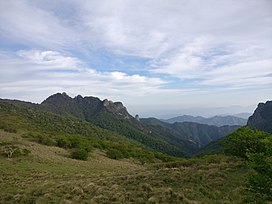Qinling
| Qinling | |||||||||
|---|---|---|---|---|---|---|---|---|---|
 | |||||||||
| Highest point | |||||||||
| Peak | Mount Taibai | ||||||||
| Elevation | 3,767 m (12,359 ft) | ||||||||
| Coordinates | 33°57′48″N107°37′05″E/ 33.96333°N 107.61806°E | ||||||||
| Naming | |||||||||
| Language of name | |||||||||
| Chinese name | |||||||||
| Traditional Chinese | TầnLĩnh | ||||||||
| Simplified Chinese | TầnLĩnh | ||||||||
| Literal meaning | QinPeak(s) | ||||||||
| |||||||||
| Former name is Southern Mountains | |||||||||
| Chinese | NamSơn | ||||||||
| |||||||||
| Geography | |||||||||
| Country | |||||||||
| Region | SouthernShaanxi Province | ||||||||
TheQinling(Chinese:Tần lĩnh) orQin Mountains,formerly known as theNanshan( "Southern Mountains" ), are a major east–westmountain rangein southernShaanxiProvince, China. The mountains mark thedividebetween thedrainage basinsof theYangtzeandYellow Riversystems, providing a natural boundary betweenNorth and South Chinaand support a huge variety of plant and wildlife, some of which is found nowhere else on earth.
To the north is the densely populatedWei Rivervalley, an ancient center of Chinese civilization. To the south is theHan Rivervalley. To the west is the line of mountains along the northern edge of theTibetan Plateau.To the east are the lowerFuniuandDabieMountains, which rise out of the coastal plain.
The northern side of the range is prone to hot weather, therain shadowcast by the physical barrier of the mountains dictating that the land to the north has asemi-aridclimate, and is consequently somewhat impoverished in regard to fertility and species diversity.[1]Furthermore, the mountains have also acted in the past as a natural defense against nomadic invasions from the north, asonly four passescross the mountains. In the late 1990s a railway tunnel and aspiralwere completed, thereby easing travel across the range.[2]
The highest mountain in the range isMount Taibaiat 3,767 meters (12,359 ft), which is about 100 kilometers (62 mi) west of the ancient Chinese capital ofXi'an.[3]Three culturally significant peaks in the range areMount Hua(2,155 meters or 7,070 feet),Mount Li(1,302 meters or 4,272 feet), andMount Maiji(1,742 meters or 5,715 feet).

Environment, flora and fauna[edit]

The environment of the Qin Mountains is adeciduousforestecoregion.[4]
The Qin Mountains form thewatershedof theYellow RiverandYangtze Riverbasins; historically, the former was home to deciduousbroadleafforests, while the latter has milder winters with more rainfall, and was generally covered in warmer, temperate, evergreen broadleaf forests. Thus, the Qin Mountains are commonly used as the demarcation line betweennorthern and southern China.
The low-elevation forests of the Qin foothills are dominated by temperate deciduous trees, likeoaks(Quercus acutissima,Q. variabilis),elm(Ulmusspp.),common walnut(Juglans regia),maple(Acerspp.),ash(Fraxinusspp.) andCeltisspp. Evergreen species of these low-elevation forests include broadleafchinquapins(Castanopsis sclerophylla), ring-cupped oaks (Quercus glauca), andconifers,likePinus massoniana.[5]
At the middle elevations, conifers, likePinus armandii,are mixed with broadleafbirch(Betulaspp.), oaks (Quercusspp.), andhornbeams(Carpinusspp.); from about 2,600 to 3,000 meters (8,500 to 9,800 ft), these mid-elevation forests give way to asubalpine forestoffirs(Abies fargesii,A. chensiensis),Cunninghamia,andbirch(Betulaspp.), withrhododendrons(Rhododendron fastigiatum) abundant in theunderstory.[5]
The region is home to a large number of rare plants, of which around 3,000 have been documented.[3]Plant and tree species native to the region includeginkgo(Ginkgo biloba—thought to be one of the oldest species of tree in the world), as well as Huashan or Armand pine (Pinus armandii), Huashan shen (Physochlaina infundibularis),Acer miaotaienseandChinese fir.[6]Timber harvesting reached a peak in the 18th century in the Qinling Mountains.[7]
The region is home to the endemicQinling panda(Ailuropoda melanoleuca qinlingensis), a brown-and-whitesubspeciesof thegiant panda(A. melanoleuca), which is protected with the help of theChangqingandFopingnature reserves.[1]An estimated 250 to 280 pandas live in the region, which is thought to represent around one-fifth of the entire wild giant panda population.[3]The Qinling Mountains are also home to many other species of wildlife, including numerousbirds,like thecrested ibis,Temminck's tragopan,golden eagle,black throatandgolden pheasants,as well as mammals like theAsiatic golden cat,Asiatic black bear,clouded leopard,golden takin,golden snub-nosed monkey,yellow-throated marten,andleopard.[8][9]
TheChinese giant salamander(Andrias davidianus), at 1.8 meters (5 ft 11 in), is one of the largestamphibiansin the world, and iscritically endangered;it is locally pursued for food, and for use of its body parts intraditional Chinese medicine.An environmental education program is being undertaken to encourage sustainable management of wild populations in the Qin Mountains, andcaptive-breedingprograms have also been set up.[10]
Weapons of mass destruction[edit]
According to the Nuclear Information Project, China "keeps most of its nuclear warheads at a central storage facility in the Qinling mountain range, though some are kept at smaller regional storage facilities."[11]
See also[edit]
References[edit]
- ^abWorld Wildlife Fund, ed. (2001)."Qinling Mountains deciduous forests".WildWorld Ecoregion Profile.National Geographic Society. Archived fromthe originalon 2010-03-08.Retrieved17 December2007.
- ^Wallis, Shani (October 1, 1999)."Qinling Breakthroughs".World Tunnelling.Archived fromthe originalon 2011-05-16.Retrieved2007-12-17– via Highbeam Research.
- ^abc"Qinling Mountains".Bookrags.com.Retrieved17 December2007.
- ^Olson, D. M; E. Dinerstein; et al. (2001)."Terrestrial Ecoregions of the World: A New Map of Life on Earth".BioScience.51(11): 933–938.doi:10.1641/0006-3568(2001)051[0933:TEOTWA]2.0.CO;2.
- ^ab"Qin Ling Mountains deciduous forests".Terrestrial Ecoregions.World Wildlife Fund.RetrievedJune 5,2011.
- ^"Qinling Mountains".Wild Giant Panda.Retrieved2007-12-17.
- ^Forest and Land Management in Imperial China By Nicholas K. Menzies
- ^"Qinling giant panda focal project".WWF China.Archived fromthe originalon 2007-10-27.Retrieved2007-12-17.
- ^Li, Jia; Li, Diqiang; Hacker, Charlotte; Dong, Wei; Wu, Bo; Xue, Yadong (2022-08-01)."Spatial co-occurrence and temporal activity patterns of sympatric mesocarnivores guild in Qinling Mountains".Global Ecology and Conservation.36:e02129.doi:10.1016/j.gecco.2022.e02129.ISSN2351-9894.
- ^"Chinese Giant Salamander".ZSL Conservation.Zoological Society of London.Retrieved2013-07-21.
- ^Kristensen, Hans; Korda, Matt (2020). "Chinese nuclear forces, 2020".Bulletin of the Atomic Scientists.76(6): 443–457.doi:10.1080/00963402.2020.1846432.S2CID228097051.
External links[edit]
 Media related toQin Lingat Wikimedia Commons
Media related toQin Lingat Wikimedia Commons


